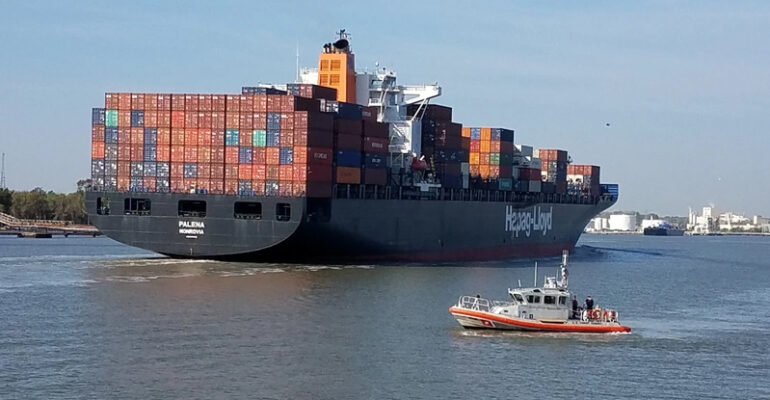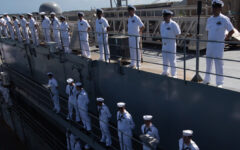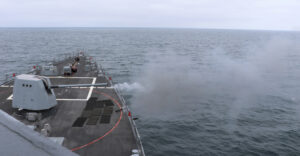Navy Readiness and the Jones Act
28 May 2024 2024-05-29 22:15Navy Readiness and the Jones Act
By Capt. Brent Ramsey, US Navy ret
After WWI, Congress passed the Merchant Marine Act of 1920. Also known as the Jones Act, it was named after the senator who was primarily responsible for its passage. It requires ships carrying cargo from one point to another in the U.S. to be American-built and -owned and crewed by U.S. citizens.
The noble purpose and intent of the law was to provide protection for U.S. shipyards, domestic carriers, and merchant marine sailors to ensure that those crucial functions are robust and ready to support the nation in times of war or emergency.
According to the Congressional Research Service, the Jones Act purports to maintain:
A merchant marine of the best equipped and most suitable types of vessels sufficient to carry the greater portion of its commerce and serve as a naval or military auxiliary in times of war or national emergency by supporting:
+ a US-controlled commercial fleet to supplement the military sealift fleet.
+ a US merchant marine workforce qualified to crew reserve military sealift vessels; and
+ domestic shipbuilding and repair capacity.
How is it doing at these intended functions? That question was answered regarding the military sealift force in the previous article in this series titled “Strategic Military Sealift Is Critical.”
There is little doubt from any source that the function of strategic sealift is not performing well at all, putting the nation at risk in wartime. The U.S. has too few strategic sealift ships, the ships we have are at a low readiness rate, and we have insufficient crews to man the ships. In terms of commercial shipyards, unfortunately, they have ceased to exist due to cost competition from overseas.
During WWII, U.S. shipbuilders built 6,000 ships. In recent years, U.S. shipbuilding has dwindled to almost nothing, with the Congressional Research Service reporting in 2019 that U.S. shipyards only build a handful of ships each year, and the cost to build here is 26 times the cost to build overseas. The primary purpose of the Jones Act has been overtaken by events. We do not have sufficient sealift or the mariners to man them, and we have few domestic shipyards for building ships that we desperately need for strategic sealift.
Aside from the complete failure of the Jones Act to perform its intended purposes of providing sealift, mariners, and shipbuilding capability, what are the other domestic impacts of the Jones Act? They are all bad. The Jones Act is protectionist. It mandates that cargo going from one port to the other in the U.S. go by ships owned by U.S. owners, registered and built in the U.S., and manned by U.S. crews. Those ships and crews largely do not exist.
The result is a huge price increase for goods moving from port to port. The increase is so large that shippers avoid it altogether. Cargo moving on foreign carriers is offloaded at one port, and much of the offloaded cargo must be moved to other parts of the country by trucks or even air — more expensive modes of transportation than by ship. This adds to highway congestion and more expense for the goods being moved.
For businesses in Hawaii to ship goods to the continental United States, it is far cheaper to ship them to Canada for subsequent trucking to the U.S. or use air transport than to use U.S. flag ships. The same applies to goods moving from Puerto Rico and Alaska to the continental U.S.
In 2014, the Congressional Research Service estimated that the Jones Act triples the cost of transportation of crude oil from the Gulf Coast, comparing the cost to move the same amount of crude to the Northeast U.S. versus to eastern Canada. Because of the Jones Act, waterborne shipping between U.S. ports costs twice what it should cost. Economists have estimated that eliminating the Jones Act would add $135 billion to U.S. economic output.
The Jones Act is estimated to increase congestion on U.S. highways by 10%, costing billions a year in added transportation costs and pollution. According to a Congressional Research Service report in 2019, “U.S. crewing costs are higher than those of foreign-flag vessels. U.S.-flag ships have an operating cost differential estimated to be over $6 million per ship per year compared to foreign-flag ships. While crewing is the primary cost element, this estimate also includes insurance and ship maintenance costs.
A 2011 study by the U.S. Maritime Administration (MARAD) found that in 2010, the average operating cost of a U.S.-flag ship was 2.7 times greater than a foreign-flag ship, but MARAD estimates that this cost differential has since increased.”
Conclusion: The Jones Act should be repealed, and the strategic sealift function should be returned to the Navy. There is no logical reason why the Merchant Marine should be responsible for strategic sealift. Furthermore, even with the Jones Act’s mandate assigning that function to the Merchant Marine (nowadays the Maritime Administration), the fact that they are failing in that mission jeopardizes the national interest and the ability of the Navy to be successful in performing its mission in time of war.






























